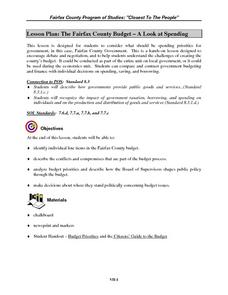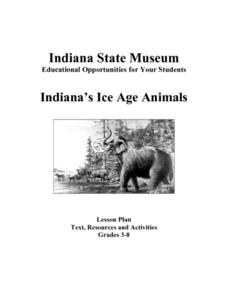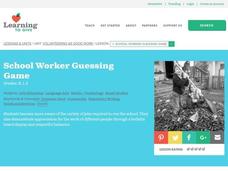Curated OER
Let's Play Scrabble!
What do Alfred Mosher Butts, James Brunot, and Jack Straus have in common? They were all instrumental in the development of Scrabble. Class members will discover these facts and many more as they conduct a WebQuest to gather, organize,...
Curated OER
Tic Tac Goal
Learners use hula hoops set up like a tic tac toe board to explore how to pass a ball by using the foot pass. Players must get their ball into one of the hula hoops to keep their ball.
Curated OER
Visual Structures of Postulates and Axioms in Algebraic Operations
High schoolers investigate Axioms and Postulates. In this proof and linear transformation of equations lesson, students explore axioms and postulates to solve linear equations. High schoolers construct game cards to analyze the linear...
Curated OER
Alphabet Soup
Students play a game in which they use the letters of the alphabet and different motor skills for review.
Curated OER
A Look At Spending
Students use an outdated budget to examine what the county spends its money on for its citizens. Using county information, they describe how the Board of Supervisors make budget decisions and how it can shape public policy. They also...
Curated OER
The Fairfax County Budget -- A Look At Spending
Students brainstorm a list of items that should be a priority for the government to help its citizens. Using an out of date budget, they identify individual line items and the conflicts involved in making a budget work. They discuss...
Curated OER
SPECTACULAR CARDS
Students get in on one of the hottest crafting trends today - handmade cards! My book explores numerous ideas for making and embellishing three types of cards - fabric, paper and board games.
Curated OER
Going with the Flow
Learners survey each other and determine their common interests. They examine the use of algorithms by various websites that are used to develop networks of interest groups among users. They then design proposals for a social networking...
Curated OER
Write to Move
Fifth graders write for their classmates in order to enjoy some physical fun. Students select a category in which they can create some locomotive skills to match the chosen category. Students write a paper explaining how to complete the...
Curated OER
Give the Dog a Bone
Students listen as the /sh/ sound is modeled and discover the sound as it appears in the words "sheep", "fish", and "ship". They then play a secret game with a magic code placing the correct dog with its bone. Once all the words are...
Curated OER
IDP Introduction
Fourth graders examine the three regions of North Carolina through class discussion of favorite places in the state and a review game based on the game of twister. The different colors on the twister sheet represent the different...
Curated OER
The Wind-Up and the Pitch
Students consider how sound affects one's experience at a ballpark and the ways that the acoustics at a baseball stadium might be improved. Students then recommend their own designs for a "soundly built" baseball stadium.
Curated OER
West Virginia Quarter Reverse: Over, Under, In, and Out
Students examine the images on the West Virginia quarter reverse. Using the quarter design as a model, the discover the meaning of directional terms. They play a game where they have to listen to and follow directions and complete a...
Curated OER
Day 1: IDP Introduction
Fourth graders locate the three regions of North Carolina (Coastal
Plains, Piedmont, and Mountain Region) and differentiate between the regions on a physical and cultural level. They identify a region based on characteristics through a...
Curated OER
Upcycled Garment or Art Work
Students explain the importance of recycling waste products. In this art lesson, students research different upcycled fashion designs and accessories. They design their own product and present it in class.
Curated OER
Calling in Sick
Learners create a dialog for calling in sick to work. Dialogs must be created for single and multiple absences. Working with a partner, students practice their dialogs. This lesson is designed for learners acquiring English.
Curated OER
Checkerboard
Students create checkerboards using paints, glue, rulers, and masking tape in this upper-elementary/middle level Art lesson. The lesson emphasizes the history of checkerboards, strategies and rules, and the checkerboard as an example of...
Curated OER
Volunteering as Good Work
Students discuss the various jobs at a school. In this school jobs lesson, students recognize the way people in the school are helped by others. Students are assigned a job and write about the help of others. Students pages are put...
Curated OER
Know Your Cousins - Monotremas, Marsupials, and Placentals
Young scholars discover various mammals. In this biology lesson plan, students recognize characteristics of mammals and categorize mammal groupings. Young scholars describe how mammals grow inside the mother's body and resemble their...
Curated OER
Historic Wilkes County
Third graders visit their local historic buildings. In this local history instructional activity, 3rd graders take a trip to their local Heritage Museum and visit a historic building. While on the trip students take pictures. Students...
Curated OER
State Economy Chart
Fifth graders research and record statistics on the economy of an assigned state. They create a spreadsheet in Excel to report the data and a 3D Pie graph using the Chart Wizard in Excel to represent their states' data.
Curated OER
Introduction to The Diary of Anne Frank
Get a glimpse of Anne Frank's years in hiding with this activity, which introduces The Diary of Anne Frank. Readers complete a journal entry about how they would keep themselves occupied if they were forced into hiding (without personal...
Curated OER
Synonyms and Antonyms
Mix up your writing lessons by having kids look at recent newspaper articles instead of their own work. They work in pairs and rewrite sports news articles using synonyms and antonyms for a set number of words. Then they share their work...
Teach Engineering
The Energy Problem
Think you can solve the energy problem? You'll first need to know about current energy use. Analyzing a set of circle graphs lets scholars see where energy consumption is the greatest, both by sector and by household use. They develop a...























